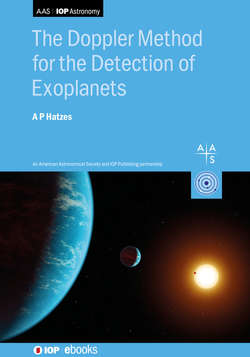Читать книгу The Doppler Method for the Detection of Exoplanets - Professor Artie Hatzes - Страница 51
На сайте Литреса книга снята с продажи.
3.3.2 Radial Velocities of Low-mass Stars
ОглавлениеThere are still relatively few exoplanets that have been found around low-mass stars (Figure 3.12). Here, the problem is not a lack of spectral information or high rotation rates, but a lack of photons. M-dwarf stars have low effective temperature, small radii, and thus low luminosities. Even nearby M-dwarf star have visual magnitudes V<10, which makes observations at high spectral resolutions. These often require large telescopes (8–10 m) with efficient spectrographs. However, there is keen interest in RV surveys for these stars as an Earth-mass planet in the habitable zone of these stars can have an RV amplitude of a few m s−1, which is achievable with state-of-the-art instruments.
M-dwarf stars have low effective temperatures, so one way to address the low number of photons from these stars is to make measurements in the near-infrared (NIR). Figure 3.15 shows the normalized spectral energy distributions of a G2 V star (the Sun) and an M4.5 V star. The G2 star has a peak in the energy distribution at 500 nm. On the other hand, the flux of the M dwarf peaks at ≈1000nm. Clearly, if you wanted a spectrograph to detect more photons from the low-mass star, it should cover the NIR wavelengths. For this reason a number of NIR spectrographs have been built for precise RV measurements of cool stars (Mahadevan et al. 2014; Quirrenbach et al. 2018; Reiners et al. 2018).
Figure 3.15. The spectral energy distribution of a G2 V star (black curve) compared to that of an M4.5 V star (red curve).
However, the RV precision one can actually achieve depends on the spectral content of a wavelength region, the number of photons you detect, but also on the presence of telluric features, which become a problem as one observes at longer wavelengths. CARMENES was the first NIR instrument that was dedicated to RV searches around M-dwarf stars (Reiners et al. 2018). It is a dual-arm high-resolution spectrograph with a resolving power R≈80,000. The visual channel (VIS) operates in the wavelength range λ = 520–960 nm, and the NIR channel covers the range λ = 960–1719 nm.
Reiners et al. (2018) investigated the RV precision as a function of wavelength for the full range of M-dwarf spectral types. For M0–M3 stars (left panel of Figure 3.16), the RV precision improves from 520 nm to 700 nm. At 700 nm, the TiO absorption band brings a lot of spectral information. In the range 700–900 nm, the RV error increases, but still produces good RV precision. At 760 nm, the TiO system at 770 nm starts to kick in. There is then a gradual increase in the RV error toward the longest wavelengths. So, for spectral types down to about M5, the RV information content in the VIS channel outperforms that in the NIR channel by a factor of 2.5.
Figure 3.16. The empirical RV precision as a function of wavelength taken from individual spectral orders from the CARMENES spectrograph. (Left) The RV precision for M0 (dots), M1 (squares), M2 (triangles), and M3 (pentagons) dwarfs. (Right) The RV precision for M6+M7 (triangles) and M9 (dots) dwarfs. The curve is a spline fit through the M0–M3 dwarf data for comparison. (Data from Reiners et al. 2018.)
For late-type stars later than M6, the spectral energy distribution starts to play a larger role. RVs can still be computed down to 600 nm, but the poorer S/N due to the decreased flux is more than a factor of 2 worse, this results in σ≈20 m s−1, compared to 3–7 m s−1 for the earlier spectral types. Because of the low flux level, the RV cannot be computed for M8 and M9 stars at wavelengths shorter than 600 nm. However, in the wavelength range λ = 1000–1600 nm, the RV performance is a factor of 2–3 higher than that for the M0–M3 stars (≈6 m s−1 compared to 10–20 m s−1). This is due to more spectral content at longer wavelengths but also more relative flux (higher S/N).
The take-home message is that for stars earlier than M5, the “sweet spot” for precise RV measurements is 600–900 nm. Suppose you want to design a spectrograph to measure precise RVs for a sample of M-dwarfs, but you only have access to a 4 m class telescope. Then a good strategy would be to build an optical high-resolution spectrograph that is optimized for the 600–900 nm region. The dwarf stars later than spectral type M5 will simply be too faint for the 4 m telescope. If on the other hand you have access to an 8 m class telescope and want to observe dwarf stars with spectral type later than M5, then a high-resolution NIR spectrograph is the instrument of choice (A. Reiners, 2018, private communication). In fact, the most efficient instrument would be a dual-arm visual and NIR spectrograph like CARMENES. In this way, high-quality RVs can be obtained for the full spectral range M0–M9.
